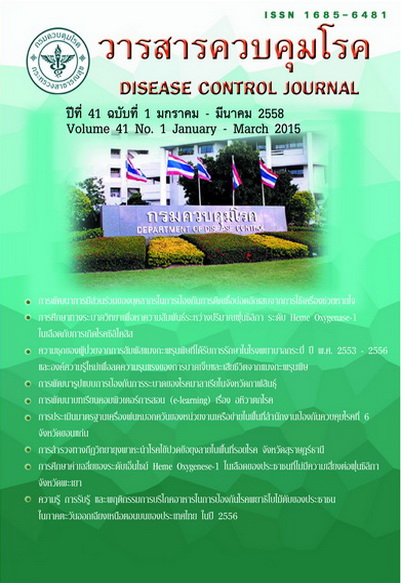Knowledge, perception and behavior about food consumption related to the prevention of Opisthorchiasis among people in upper northeastern Thailand in 2013
DOI:
https://doi.org/10.14456/dcj.2015.34Keywords:
knowledge, perception, behavior, Opisthorchis ViverriniAbstract
Opisthorchis Viverrini (OV) or Liver fluke is one of major public health problem for many countries in Southeast Asia, including upper northeastern region of Thailand as well. The main cause of the disease is due to eating raw fishes of uncooked fish product. This study was a cross-section survey with the main objectives to study knowledge, perception and behavior at risk of OV infection and relating factors that enabling appropriate change of risk behavior of people in the upper northeastern region of Thailand. The population study were 3,915 people of >15 years who were randomized by thirty cluster survey from the population of seven provinces of the upper northeastern region. Research instrument was questionnaire. De¬scriptive and inferential statistics were employed in data analysis. The research result showed that forty one point two percent of them did not know the appropriate cooking to kill the causative agent, while fifty five point two percent did not know the risk of eating raw fish towards the diseases. They, however, perceived clearly that eating raw fish was their own life style which was inherited from their ancestors who were familiarized and very fond of food cooking from raw fish. That was why fifty seven point one percent of them were still eating raw fish and ninety two point six percent liked eating raw fermented foods. Meanwhile, it was found that fifty two percent of them never thought to change their risk behavior. In regard to factors related to modification of such risk behavior, sex, risk meal eating behavior, education, occupation and family history of liver cancer and cancer of bile duct were statistically significant factors with 0.05 confidence interval (p-value 0.001, 0.002, 0.003, 0.004 and 0.034) respectively. These important factors, there¬fore were necessary to explain their willingness and commitment to modify their eating behavior. Authors concluded that, in order to achieve better interventions for modification of risk behaviors of upper northeastern people, more continuously effective education and behavior modification must be delivered to them with a very strong political and local commitments and supports.
Downloads
References
2. Sripa B, Bethony JM, Sithithawom P. Opisthorchiasis and Opisthorchis-associated cholangio-carcinoma in Thailand and Laos. Acta Trop 2011;120:158-68.
3. Prommas C. Report of a case of Opisthorchis felineus in Siam. Ann Trop Med Parasitol 1927;21:9-10.
4. Vatanasapt V, Tangvoraphonkchai V, Titapant V, Pipitgool V, Viriyapap D, Sriampom S. A high incidence of liver cancer in Khon Kaen Province, Thailand. Southeast Asian J Trop Med Public Health 1990;21:489-94.
5. Haswell-Elkins MR, Mairiang E, Mairiang P, Chaiyakum J, Chamadol N, Loapaiboon V. Cross-sectional study of Opisthorchis viverrini infection and cholangiocarcinoma in communi¬ties within a high-risk area in northeast Thailand. Int J Cancer 1994;59:505-9.
6. Viranuvatti V, Kasamsant D, Bhamarapravati N. Retention cyst of liver caused by opisthorchiasis associated with cholangiocarcinoma. Am J Gastroenterol 1955;23:442-6.
7. Kheng-Wei Y. Resurvey of Opisthorchis viverrini Infection in northeast Thailand [A dissertation for MSc in Global Health]. Oxford: University of Oxford; 2006.
8. พนัชพร จันทะผอง, มัณธนี จันทพัฒน์, ภาณุมาศ ไกรสร, กฤษดา อุทานนท์, ธนาวัฒน์ อุปพงษ์, ศรายุทธ ส่วนบุญ, และคณะ. ความรู้และพฤติกรรมเสี่ยงเรื่องการติดเชื้อพยาธิใบไม้ตับในนักเรียนมัธยมศึกษาตอนปลาย ในเขตเทศบาลนครขอนแก่น. ศรีนครินทร์เวชสาร 2556;28:239-45.
9. Suwannahitatorn P, Klomjit S, Naaglor T, Taamasri P, Rangsin R, Leelayoova S, et al. A follow-up study of Opisthorchis viverrini infection after the implementation of control program in a rural community, central Thailand. Parasites & Vectors 2013;6: 188.
10. Kaewpitoon N, Kaewpitoon S, Pengsaa P, Pilasr C. Knowledge, attitude and practice related to liver fluke infection in northeast Thailand. World J Gastroenterol 2007;13:1837-40.
11. วนิดา โชควาณิชย์พงษ์, อำไพ สารขันธ์, ศุลีพร แสงกระจ่าง. การสำรวจพฤติกรรมและทัศนคติการบริโภคปลาดิบและการเกิดมะเร็งท่อน้ำดี. วารสารโรคมะเร็ง 2552;29:162-75.
12. Cronbach, L.J. Coefficient alpha and the internal structure of tests. Sychometrika 1951; 16:297-334.
13. ภูเบศร์ แสงสว่าง. การใช้ยาพราซิควอนเทลและอัตราการติดเชื้อซ้ำในผู้ติดเชื้อพยาธิใบไม้ตับ [วิทยานิพนธ์ปริญญาสาธารณสุขศาสตรดุษฎีบัณฑิต]. ขอนแก่น: มหาวิทยาลัยขอนแก่น; 2556.
14. Pungpak S, Bunnag D, Harinasuta T. Studies on the chemotherapy of human Opisthorchiasis: Effective dose of praziquantel in heavy infection. Southeast Asian J Trop Med Public Health 1985;16:248-52.
15. Watana P, Watana WB. Liver fluke-associated cholangiocarcinoma. Br J Surg 2002;89:962- 70.
16. Poomphakwaen K, Promthet S, Kamsa-ard S. Risk factors for holangiocarcinoma in KhonKaen, Thailand: a nested case-control study. Asain Pac J Cancer Prev 2009;10:251-7.
17. Songserm N, Promthet S, Sithithawom P. Risk factors for cholangiocarcinoma in high risk area of Thailand: Role of lifestyle, diet and methylenetetrahydrofolate reductase polym-morhisms. Cancer Epidemiology 2012;36:89- 94.
Downloads
Published
How to Cite
Issue
Section
License
Articles published in the Disease Control Journal are considered as academic work, research or analysis of the personal opinion of the authors, not the opinion of the Thailand Department of Disease Control or editorial team. The authors must be responsible for their articles.






